Animals
How many species of rhino exist? + Rhinos Lifespan, Diet and Weight

How many species of rhino exist?
There are 5 distinct species of rhinoceros
Gain a better understanding of the five distinct species of rhinoceros.
Rhinos used to be widespread over Europe, Asia, and Africa, and early Europeans depicted them in cave paintings since they were familiar with these animals at that time.
At the turn of the 20th century, there were approximately 500,000 rhinos living throughout Africa and Asia.
There are currently five species of living rhinos, despite the fact that there have been close to 100 known species of rhinoceros over the course of the eons.

Source: instagram
There are two different species of rhinoceros in Africa, while there are three different kinds in Asia. The black rhinoceros (Diceros bicornis) and the white rhinoceros (Rhinoceros simum) are both found in Africa.
Rhinos often live in communities alongside a variety of other important plants and animals. The conservation of greater one-horned rhinos contributes to the conservation of the aforementioned other species.
These rhinos also serve as a symbol of national pride in the countries in which they are found, which motivates the local communities to take better care of their surrounding environment.
These communities also gain benefits from the revenue that is generated from ecotourism related to rhinos.
Rhinos Size and Weight:
The size and weight of rhinos can vary greatly from species to species. Their height can range anywhere from 1 to 3 meters (3.3 to 10.1 ft).
The Sumatran rhino is the smallest of the rhinoceroses that are still alive today.
Their height can range anywhere from 3.3 to 5 feet, their length can range anywhere from 6.5 to 13 feet, and their weight can range anywhere from 1,320 to 2,090 pounds.
The smaller of the two kinds of rhinoceros found in Africa are the black rhinos.
Their height is anywhere from 5.2 feet to 5.2 feet, and their weight ranges anywhere from 1,720 pounds to 3,080 pounds.
The white rhinoceros is the larger of the two kinds of rhinoceros found in Africa. It can weigh between 3,080 and 7,920 pounds and can stand between 5 and 6 feet tall.
Javan rhinoceroses can range in size from 4.6 to 5.8 feet in height and anything from 1,984 to 5,071 pounds in weight.
View this post on Instagram
The greater one-horned rhinoceros is the largest of the rhino species, ranging in height from 5.75 to 6.5 feet and in weight from 4,000 to 6,000 pounds. Its height can range from 5.75 to 6.5 feet.
Rhinoceros Diet:
There are five different kinds of rhinoceros, but they are all herbivores that consume mostly plants. They spend the most of their time rummaging through their natural habitat and grazing in order to find edible plants and grasses to consume.
The particular kinds of food that each species consumes are determined by the ecosystem in which they live as well as their geographic location.
Rhinos are one of the few megaherbivores, or herbivores that consume more than 2,000 pounds of vegetation annually, that are still alive today.
Rhinos Habitat:
Rhinos can be found in a variety of habitats, some of which include tropical and subtropical grasslands, savannas and shrublands. They can also be found in tropical moist forests, deserts, and shrublands.
The species determines the habitat that they inhabit. For instance, the habitat of the Sumatran rhinoceros consists of deep tropical and subtropical forests both in the highlands and the lowlands.
On the meanwhile, the white rhinoceros can be found in the grasslands of Africa.
Geography:
Rhinos previously inhabited vast swaths of Africa and Asia, but in recent years, their habitat has shrunk by a significant amount across both continents.
There are known populations of rhinos in Borneo and Sumatra, as well as in Namibia, the Eastern Himalayas, and East Africa’s Coastal region.
The species determines where they can be found. For instance, the Sumatran rhinoceros can be found on both the island of Sumatra and the island of Borneo in Indonesia.
Both the white rhino and the black rhino can be found in their natural habitat in Africa.
Rhino Lifespan:
It depends on the species of rhinoceros how long they live. The average lifespan of a rhino is between 40 and 45 years.
Threats Affecting Rhinoceros:
The Javan rhinoceros is the most endangered of the 5 species of rhinoceros and can be found in just one protected area across the entire planet.
The species is in grave danger of going extinct as a result of natural disasters, the destruction of its habitat, infectious diseases, illegal poaching, and the possibility of inbreeding.
The Javan rhinoceros and the Sumatran rhino both vie for the distinction of the world’s most endangered species of rhinoceros.
Sumatran rhinos may still be around in larger numbers than Javan rhinos, but they face a greater risk of extinction as a result of the destruction and fragmentation of their natural habitat.
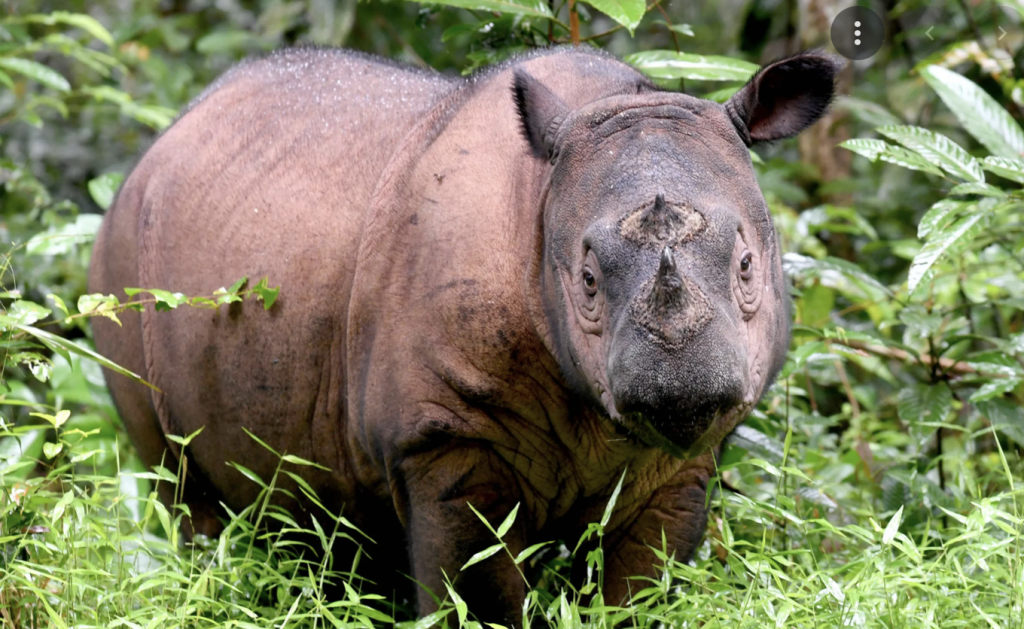
Sumatran rhinos
The remaining animals live in small, fragmented populations that are not viable, and because there are fewer opportunities for them to discover each other and breed, the population is continuing to drop.
During the past 15 years, reproduction has been achieved by only two of the captive females.
The greatest danger that the one-horned rhinoceros faces is the act of poaching. Traditional Asian medicine makes use of their horn in various preparations.
Another big risk is the destruction of habitat because of rising human population levels.
Both black and white rhinos face their greatest danger from poaching and other illegal activities in Africa.
Poaching for rhino horn has reached epidemic proportions over the past several decades, bringing the white rhino to the brink of extinction.
Loss of habitat is another significant risk factor for both species.
Here are the Top 5 Rhino Species
1. The Javan Rhino

The Javan rhinoceros is the most endangered of the five species of rhinoceros because there are only about 60 of them left, and they can only be found in Ujung Kulon National Park on the island of Java in Indonesia.
There was a time when Javan rhinos could be found all over northeast India and Southeast Asia.
The only Javan rhino in Vietnam was killed by poachers in the year 2010.
This species is a dingy gray tint, and it has a single horn that can grow to be approximately 10 inches long. It appears as though the creature’s skin is armored due to the presence of a number of loose folds.
The Javan rhino is quite similar in appearance to the bigger one-horned rhinoceros, which is a near relative of the Javan rhino, but the Javan rhino has a considerably smaller head and fewer obvious skin folds.
The population that can be found in Ujung Kulon National Park is the only one that offers any chance of survival for a species that is dangerously close to going extinct.
Up to the late 19th century and the early 20th century, Javan rhinos could be found on the island of Sumatra, as well as on the mainland of Southeast Asia, the Sunderbans, and northeastern India.
If we are unable to maintain the population in Java, the species as a whole will perish.
The Javan rhinoceros is the species of rhinoceros that is most in risk of extinction, and its population is decreasing at a rate of 1% every year.
Poaching for their horns is still one of the primary dangers to their continued existence, which helps to explain why it is one of the most endangered animals in the world.
If you wish to do something to assist with their protection, you can make a financial contribution or encourage your friends and family members to do the same thing.
2. The Sumatran Rhino
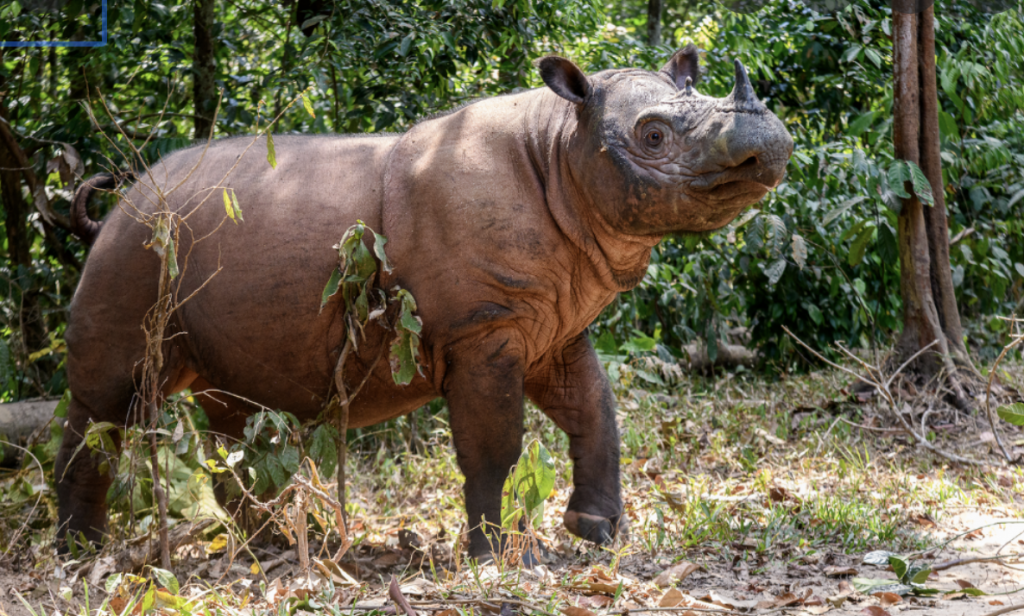
The Sumatran rhino is one of the world’s most critically endangered species and there are only around 100 left in the world.
Poaching for their horn has led to a dramatic decrease in their population over the years, and currently they face extinction unless we take action quickly.
Various conservation initiatives are underway to help protect them from extinction, but if you want to make a real impact, learning about their plight and getting involved is essential.
There are various ways you can help – donating money, campaigning for change online or even by participating in protests organised by conservation groups near where you live.
THIS IS THE LAST CHANCE WE HAVE TO SAVE THE SUMATRAN RHINOS
The few remaining Sumatran rhinos are battling to survive in the deep, humid rainforests of the Indonesian islands of Sumatra and Borneo.
This rhino is so uncommon, with less than 80 individuals surviving in dispersed subpopulations, that only a few of people have ever seen one in the wild.
Initial causes of the species’ decline were habitat loss and poaching for their horns, both of which exist today. Despite continuous protection, extinction is imminent for the species.
Sumatran rhinos have been isolated in tiny regions, reducing the likelihood of breeding-age animals coming into contact with one another. There are simply not enough newborn rhinos being born.
THE ALLIANCE
The only way to bring the Sumatran rhino back from the verge of extinction is to consolidate the fragmented wild populations into managed breeding facilities constructed expressly for their care and propagation, according to Indonesian government officials and rhino experts.
Without this assistance, these rhinoceroses will go extinct within a few decades.
We recently partnered with the Indonesian government, National Geographic, the World Wildlife Fund, the International Union for the Conservation of Nature, and Global Wildlife Conservation to save the Sumatran rhino from extinction.
The initiative was designed to support the national Sumatran rhino breeding program of the Indonesian government.
3. The Black Rhino
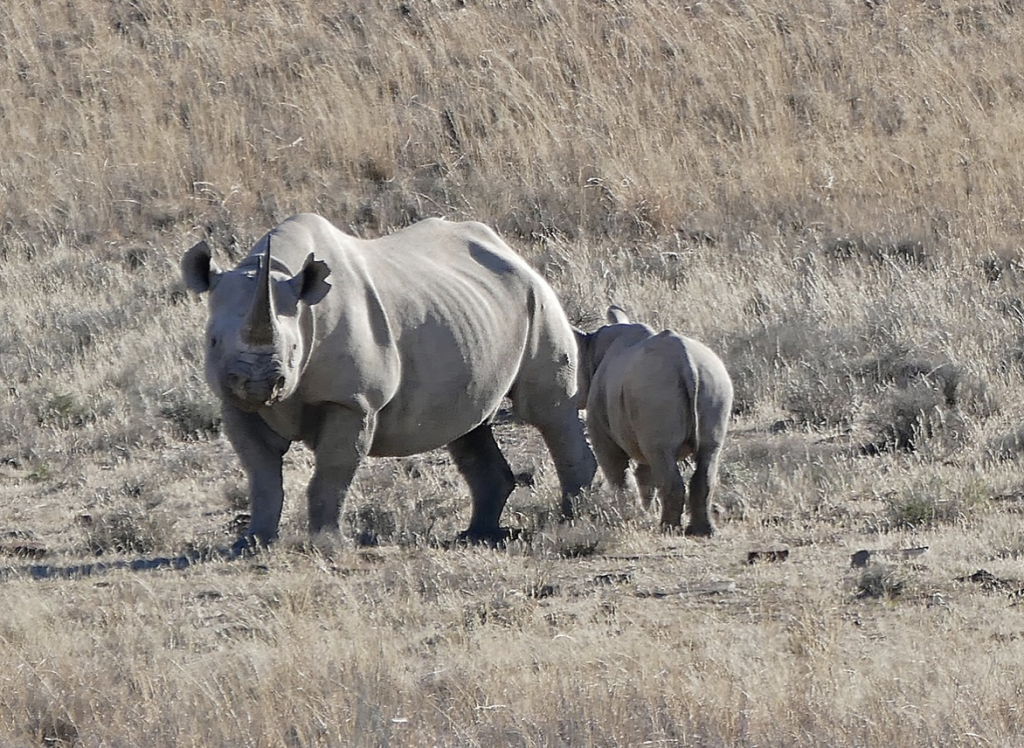
Rhino poaching is one of the biggest conservation threats facing black rhinos.
Poachers hunt these animals for their horns, which are believed to have medicinal properties in some cultures.
The black rhinoceros is the smallest of the two kinds of African rhinoceros. White and black rhinos are distinguished from one another by their hooked upper lip.
This distinguishes them from the white rhino, whose upper lip is square.
Black rhinos are browsers as opposed to grazers, and their hooked upper lip enables them to consume leaves from bushes and trees. They typically have two horns, with the occasional addition of a third, little posterior horn.
As a result of European hunters and settlers, black rhino populations dropped substantially over the 20th century.
Between 1960 and 1995, the number of black rhinos plummeted by 98%, to less than 2,500.
Since then, the species has made a remarkable recovery after being on the verge of extinction.
The number of black rhinos has more than doubled from its historic low 20-years ago to approximately 5,500 now, as a result of ongoing conservation efforts across Africa.
However, the black rhino is still regarded to be critically endangered, and there is still a great deal of effort to be done to increase its population to even a fraction of its former size and to ensure that it remains there.
Wildlife crime, in this case poaching and illegal trade of rhino horn, continues to plague and jeopardize the species’ recovery.
Since 1990, the population of black rhino has decreased by 95%, and as of 2016 there were only 2,000 left in the world – down from over 20,000 just two decades ago.
If you’re thinking of buying or selling a horn – don’t! Not only will this help support poachers, but it also sends out a negative message about rhinos and encourages people to kill them.
You can help protect these endangered animals by not supporting any kind of illegal wildlife trade.
4. The Greater one-Horned Rhino
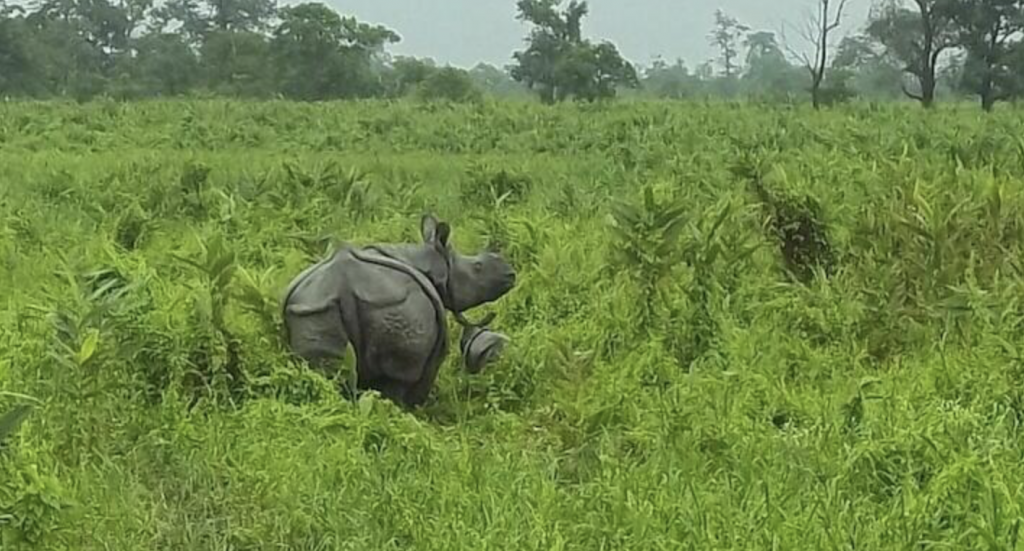
The greater one-horned rhino is one of the world’s most endangered rhinos and their population is on the decline.
The largest member of the rhinoceros family is the bigger one-horned rhino, sometimes known as the “Indian rhino.”
The decline of rhino populations can be attributed to hunting for sport and the culling of rhinos as agricultural pests.
Rhino populations were once abundant throughout the whole northern portion of the Indian subcontinent. This brought the species to the brink of extinction, and by the beginning of the 20th century, there were only approximately 200 greater one-horned rhinos living in the wild.
The comeback of the greater one-horned rhinoceros is one of the most remarkable examples of successful conservation efforts in Asia.
The greater one-horned rhinoceros was brought back from the brink of extinction because to the stringent protection and management practices implemented by Indian and Nepalese wildlife officials.
There are approximately 3,700 rhinos living in the Terai grasslands of Nepal and the northeastern part of India today.
The greater one-horned rhinoceros can be distinguished from other species of rhinoceros by its solitary, dark horn, which can range in length from 8 to 25 – inches, and its gray-brown hide, which features skin folds that give it the appearance of being armor-plated.
The species mostly lives alone, with the exception of situations in which adult males or rhinos that are getting close to reaching adulthood congregate at wallows or to graze.
Males have home ranges that are only hazily defined, are not effectively protected, and frequently overlap with those of other males.
They do most of their eating by grazing, and eating grasses, leaves, and branches of shrubs and trees, fruits, and aquatic plants that make up their diet make up almost all of what they consume.
Poaching for their horns is the main reason for this, as horn prices have increased exponentially in recent years due to growing demand from China and other countries in East Asia.
You can help reduce poaching by educating yourself and others about the importance of conservation – By supporting conservation efforts you’re helping ensure that this magnificent animal will continue to thrive into the future.
5. The White Rhino

The Ceratotherium simum, more often known as the white rhinoceros, white rhino, or square-lipped rhinoceros, is the largest species of rhinoceros that is still alive today.
It is the most sociable of all rhino species and has the widest mouth of any rhino, which it uses for grazing.
There are two subspecies of the white rhinoceros:
The southern white rhinoceros, which was estimated to have between 19,682 and 21,077 alive in the wild in the year 2015, and the far more uncommon northern white rhinoceros.
Poaching is the primary factor contributing to the dwindling population of white rhinos.
In the past four years, there has been a drop in population of over 12%, from an estimated 18,067 people to fewer than 16,000 people presently.
The white rhinoceros, together with the bigger one-horned rhino, which is nearly the same size as the white rhinoceros, is the second largest terrestrial mammal after the elephant.
There are two separate subspecies of this animal, but the only group that continues to thrive is the southern white rhino (Ceratotherium simum simum).
Poaching has caused the extinction of the northern white rhino (Ceratotherium simum cottoni), and there are just two females left living in a sanctuary in East Africa.
Did the white rhino go extinct?
After more than a century of protection and management, they are currently categorized as Near Threatened, and there are approximately 18,000 animals in protected areas and private game reserves.
They are the only non-endangered species among the five rhinoceros species. White rhino social structures are intricate.
Conclusion
We hope you enjoyed this article… What are your thoughts?
Please feel free to share with us in the comments section below.
Animals
The Ethics of Animal Testing: Navigating the Complex Intersection of Science and Compassion
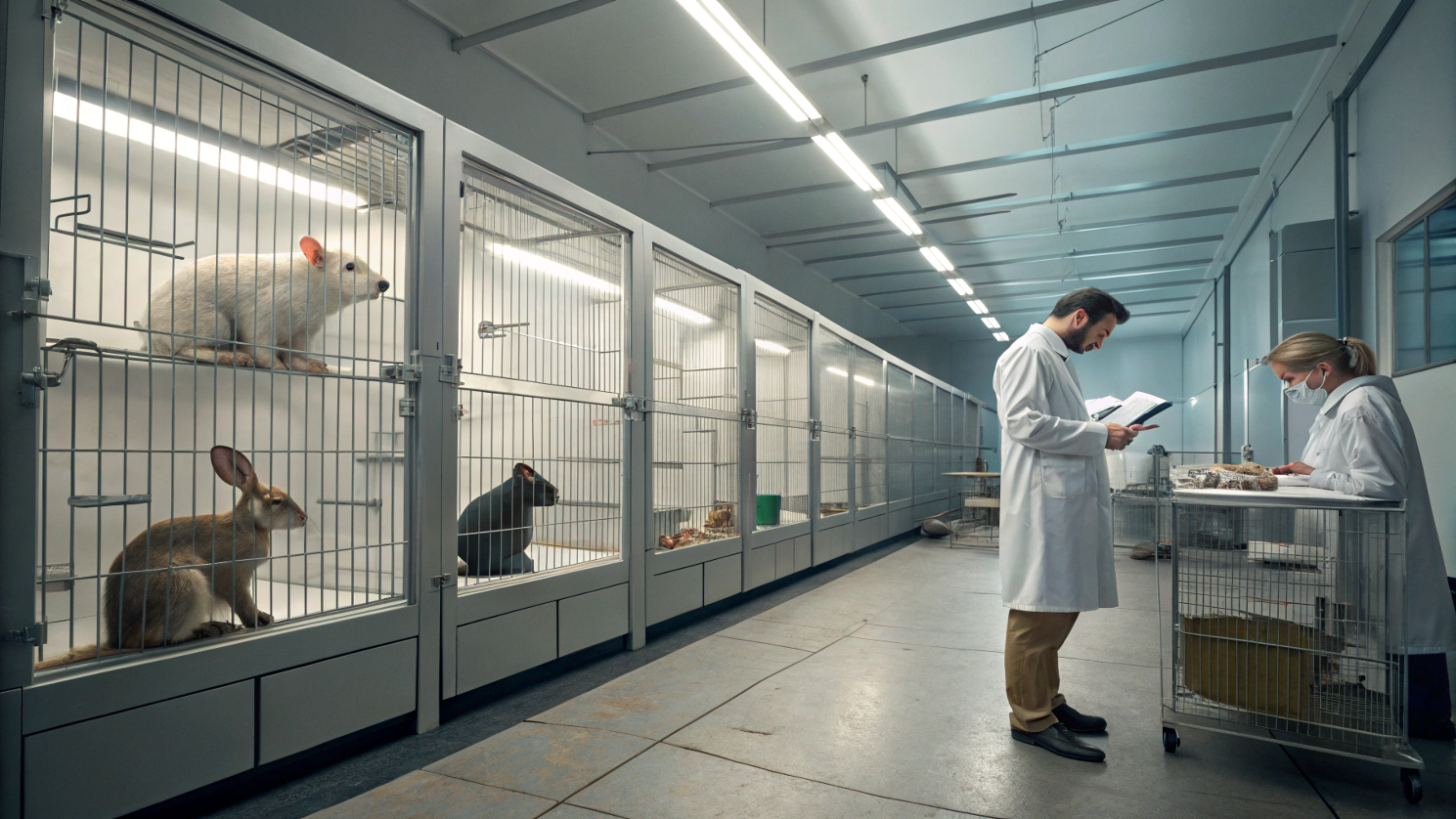
Animal testing has long been a contentious issue, sparking debates that span scientific, ethical, and philosophical domains. On one hand, animal testing has played a crucial role in advancing medical research, leading to breakthroughs in the treatment of diseases, the development of new drugs, and the understanding of biological processes.
On the other hand, the use of animals in experiments raises significant ethical concerns about animal welfare, the moral implications of causing suffering, and the validity of extrapolating results from animals to humans.
This article delves into the ethics of animal testing, exploring the arguments for and against it, the current state of regulations, and the ongoing quest to find alternatives that balance scientific progress with compassion for animals.
The Role of Animal Testing in Science
Historical Contributions
Animal testing has been instrumental in numerous scientific advancements. For instance, the development of vaccines for diseases such as polio and rabies relied heavily on animal experiments. Similarly, the discovery of insulin and the development of antibiotics were made possible through research involving animals.
Current Applications
Today, animal testing is used in a variety of fields, including:
- Medical Research: Testing new drugs, treatments, and surgical procedures.
- Toxicology: Assessing the safety of chemicals, cosmetics, and other products.
- Basic Science: Understanding biological processes and disease mechanisms.
Case Study: The Development of the Polio Vaccine
The development of the polio vaccine in the mid-20th century is a prime example of the importance of animal testing. Researchers used monkeys and mice to test the safety and efficacy of the vaccine before it was administered to humans, leading to the eventual eradication of polio in many parts of the world.
The Ethical Debate
Arguments in Favor of Animal Testing
Arguments Against Animal Testing
Case Study: The Thalidomide Tragedy
The thalidomide tragedy is a stark example of the limitations of animal testing. Thalidomide was tested on animals and deemed safe, but it caused thousands of birth defects in humans. This case highlights the potential for discrepancies between animal and human responses to drugs.
Current Regulations and Ethical Guidelines
International and National Regulations
Animal testing is subject to regulations and guidelines that vary by country. In the United States, the Animal Welfare Act and the Public Health Service Policy on Humane Care and Use of Laboratory Animals provide a framework for the ethical treatment of animals in research. The European Union has implemented the Directive 2010/63/EU, which sets strict standards for animal testing and promotes the use of alternatives.
The 3Rs Principle
The 3Rs principle—Replacement, Reduction, and Refinement—is a cornerstone of ethical animal testing. It advocates for:
- Replacement: Using alternative methods, such as computer modeling and in vitro studies, to replace animal testing.
- Reduction: Minimizing the number of animals used in experiments.
- Refinement: Improving experimental procedures to minimize pain and distress.
The Quest for Alternatives
In Vitro and In Silico Methods
Advances in technology have led to the development of alternative methods that reduce or eliminate the need for animal testing. In vitro methods, such as cell cultures and tissue engineering, allow researchers to study biological processes without using animals. In silico methods, such as computer modeling and simulation, provide tools for predicting the effects of drugs and chemicals.
Case Study: The Human-on-a-Chip
The “human-on-a-chip” is an innovative technology that uses microfluidic devices to mimic human organ systems. This technology has the potential to revolutionize drug testing by providing more accurate and ethical alternatives to animal models.
Public and Scientific Opinion
Public opinion on animal testing is divided, with many people calling for stricter regulations and the development of alternatives. Within the scientific community, there is growing interest in finding alternatives to animal testing, driven by ethical concerns and the limitations of animal models.
Conclusion: Striking a Balance
The ethics of animal testing is a complex and multifaceted issue that requires a delicate balance between scientific progress and compassion for animals. While animal testing has contributed to significant advancements in science and medicine, it is crucial to continue exploring and implementing alternatives that minimize animal suffering and address the ethical concerns surrounding the use of animals in research.
Frequently Asked Questions (FAQs)
1. What is animal testing?
Animal testing, also known as animal experimentation, is the use of animals in scientific research to study biological processes, test the safety and efficacy of drugs and chemicals, and develop new medical treatments.
2. Why is animal testing controversial?
Animal testing is controversial because it raises ethical concerns about animal welfare, the moral implications of causing suffering, and the validity of extrapolating results from animals to humans.
3. What are the alternatives to animal testing?
Alternatives to animal testing include in vitro methods, such as cell cultures and tissue engineering, and in silico methods, such as computer modeling and simulation.
4. What is the 3Rs principle?
The 3Rs principle—Replacement, Reduction, and Refinement—advocates for the use of alternatives to animal testing, minimizing the number of animals used, and improving experimental procedures to minimize pain and distress.
5. How can individuals support ethical animal testing?
Individuals can support ethical animal testing by advocating for the development and use of alternatives, supporting organizations that promote animal welfare, and staying informed about the issues surrounding animal testing.
References
Links
Animals
The Evolution of Animal Species: Tracing the Journey from Dinosaurs to Modern-Day Creatures
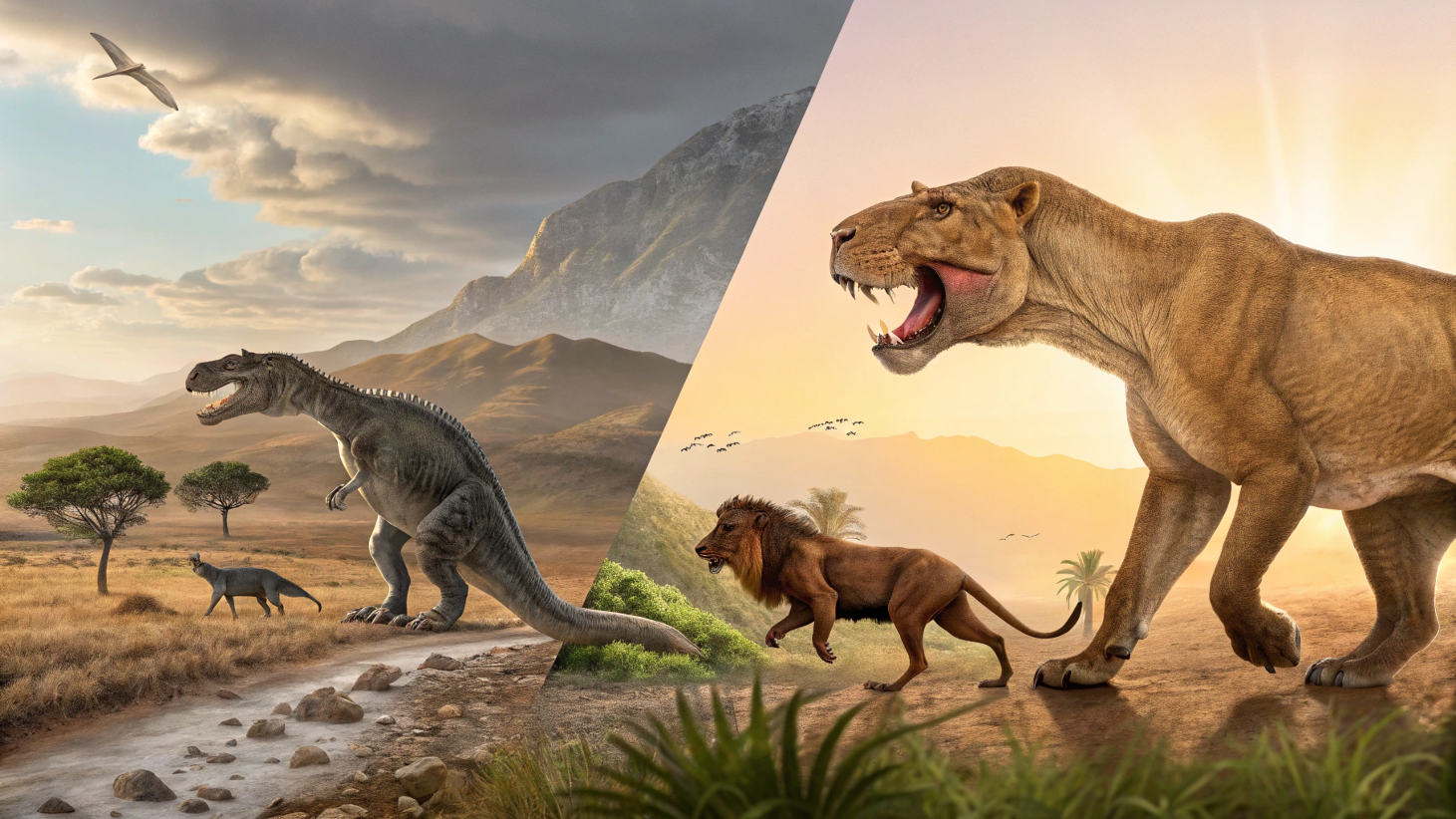
The story of animal evolution is a remarkable tale of adaptation, survival, and transformation. Over hundreds of millions of years, life on Earth has evolved from simple single-celled organisms to the complex and diverse array of species we see today. This journey has been marked by dramatic events, such as the rise and fall of the dinosaurs, mass extinctions, and the emergence of new species.
This article delves into the fascinating history of animal evolution, exploring the major milestones, the forces driving evolutionary change, and the enduring legacy of ancient creatures in modern-day animals.
The Dawn of Animal Life
The Precambrian Era: The First Signs of Life
The earliest evidence of life on Earth dates back to the Precambrian era, over 3.5 billion years ago. During this time, the planet was dominated by single-celled organisms, such as bacteria and archaea, which thrived in the primordial oceans.
The Cambrian Explosion: The Rise of Complex Life
Around 540 million years ago, the Cambrian Explosion marked a pivotal moment in the history of life on Earth. Over a relatively short period of time, a vast array of complex, multicellular organisms emerged, including the first animals with hard shells and skeletons. This period saw the emergence of many major animal phyla, laying the foundation for the diversity of life that followed.
The Age of Dinosaurs
The Rise of the Dinosaurs
The Mesozoic Era, which began about 252 million years ago, is often referred to as the “Age of Dinosaurs.” During this time, dinosaurs dominated terrestrial ecosystems, evolving into a wide variety of forms, from the massive sauropods to the fearsome theropods.
Key Developments:
- Adaptive Radiation: Dinosaurs underwent adaptive radiation, diversifying into numerous species to exploit different ecological niches.
- Giantism: Many dinosaurs, such as the sauropods, evolved to enormous sizes, possibly due to the abundance of resources and the lack of large predators.
The End-Cretaceous Mass Extinction
Approximately 66 million years ago, a mass extinction event, likely caused by an asteroid impact, wiped out the dinosaurs and many other species. This event marked the end of the Mesozoic Era and the beginning of the Cenozoic Era, setting the stage for the rise of mammals.
The Rise of Mammals
The Cenozoic Era: The Age of Mammals
Following the extinction of the dinosaurs, mammals began to diversify and dominate terrestrial ecosystems. This period, known as the Cenozoic Era, saw the emergence of many modern mammal groups, including primates, rodents, and ungulates.
Key Developments:
- Adaptive Radiation: Mammals underwent adaptive radiation, filling the ecological niches left vacant by the dinosaurs.
- Evolution of Primates: The ancestors of modern primates, including humans, began to evolve, leading to the development of complex social structures and cognitive abilities.
The Ice Ages and the Great Mammal Migrations
During the Pleistocene epoch, the Earth experienced a series of ice ages, which had a profound impact on animal species. Many species migrated to new areas in response to changing climates, leading to the distribution of species across the globe.
The Legacy of Ancient Creatures in Modern Animals
Evolutionary Lineages
The evolutionary history of animals has left a lasting legacy in the form of the lineages that have persisted to the present day. Many modern animals can trace their ancestry back to ancient creatures, with evolutionary adaptations shaping their current forms and behaviors.
Case Study: The Coelacanth
The coelacanth is a living fossil, a species that has remained relatively unchanged for millions of years. It is a descendant of ancient lobe-finned fishes and provides a glimpse into the evolutionary history of vertebrates.
Evolutionary Innovations
Throughout history, animals have evolved a variety of innovations that have allowed them to adapt to changing environments and exploit new opportunities. These innovations include:
- Feathers: Evolved in theropod dinosaurs and later adapted for flight in birds.
- Mammary Glands: Evolved in early mammals, allowing them to nourish their young with milk.
- Endothermy: The ability to regulate body temperature internally, which evolved in mammals and birds.
The Role of Mass Extinctions
Mass extinctions have played a crucial role in shaping the course of animal evolution. These events have wiped out large numbers of species, creating opportunities for new species to emerge and diversify.
Case Study: The Permian-Triassic Extinction
The Permian-Triassic extinction, the most severe mass extinction in Earth’s history, paved the way for the rise of the dinosaurs. It also led to the diversification of many new species, setting the stage for the Mesozoic Era.
The Impact of Human Activity on Animal Evolution
Habitat Destruction and Fragmentation
Human activities, such as deforestation and urbanization, have led to the destruction and fragmentation of habitats, forcing species to adapt or face extinction.
Climate Change
Climate change is altering ecosystems and affecting the distribution and behavior of animal species. Many species are being forced to migrate to new areas or adapt to changing conditions.
Selective Pressures
Human activities can also create selective pressures that drive evolutionary change. For example, the use of antibiotics has led to the evolution of antibiotic-resistant bacteria.
Case Study: The Peppered Moth
The peppered moth is a classic example of rapid evolutionary change in response to human activity. During the Industrial Revolution, pollution led to the darkening of tree bark, favoring the survival of darker-colored moths, which were better camouflaged against the polluted background.
Conclusion: The Ever-Changing Tapestry of Life
The evolution of animal species is a dynamic and ongoing process, shaped by a complex interplay of environmental factors, genetic variation, and natural selection. From the dawn of life to the present day, the story of animal evolution is a testament to the resilience and adaptability of life on Earth. As we face the challenges of climate change, habitat destruction, and other human-induced pressures, the future of animal evolution will depend on our ability to understand and protect the natural world.
Frequently Asked Questions (FAQs)
1. What is the oldest animal species still in existence?
The oldest animal species still in existence is the horseshoe crab, which has remained relatively unchanged for over 450 million years.
2. How do mass extinctions affect animal evolution?
Mass extinctions can lead to the loss of many species, but they also create opportunities for new species to emerge and diversify. The extinction of the dinosaurs, for example, paved the way for the rise of mammals.
3. What is adaptive radiation?
Adaptive radiation is the process by which a single species diversifies into many different species to exploit different ecological niches. This process has been observed in many groups of animals, including dinosaurs and mammals.
4. How has human activity influenced animal evolution?
Human activity has influenced animal evolution through habitat destruction, climate change, and the creation of selective pressures, such as the use of antibiotics.
5. What is the role of natural selection in animal evolution?
Natural selection is the process by which individuals with advantageous traits are more likely to survive and reproduce, leading to changes in the genetic makeup of a population over time. This process is a key driver of evolutionary change.
References
Links
Animals
The Benefits of Animal-Assisted Therapy: How Animals Can Help Humans Heal

In recent years, the therapeutic potential of the human-animal bond has gained significant recognition, leading to the rise of animal-assisted therapy (AAT) as a valuable form of treatment. Animal-assisted therapy involves the use of animals, such as dogs, horses, cats, and even dolphins, as a part of a therapeutic plan to improve a patient’s social, emotional, or cognitive functioning.
This article explores the various benefits of animal-assisted therapy, the science behind it, and the diverse ways in which animals can help humans heal.
What is Animal-Assisted Therapy?
Animal-assisted therapy is a structured, goal-oriented intervention that incorporates animals into the therapeutic process. Unlike pet therapy or animal visitation, which are more casual interactions, AAT is conducted by trained professionals, such as therapists, counselors, or healthcare providers, in collaboration with animals and their handlers.
Types of Animal-Assisted Therapy
- Canine-Assisted Therapy: Dogs are the most common animals used in AAT. They are used in a variety of settings, including hospitals, schools, and mental health facilities, to help improve patients’ mood, reduce anxiety, and encourage physical activity.
- Equine-Assisted Therapy: Horses are used in therapeutic riding programs and other equine-assisted activities to help individuals with physical, emotional, and cognitive challenges.
- Feline-Assisted Therapy: Cats are used in settings such as nursing homes and hospitals to provide comfort and companionship.
- Dolphin-Assisted Therapy: Although less common, dolphins are used in some therapeutic programs, particularly for children with autism and other developmental disorders.
The Benefits of Animal-Assisted Therapy
1. Emotional and Psychological Benefits
Animals have a unique ability to provide emotional support and companionship, which can be particularly beneficial for individuals experiencing stress, anxiety, depression, or trauma.
Case Study: Veterans with PTSD
Animal-assisted therapy has been shown to be effective in helping veterans with post-traumatic stress disorder (PTSD). The presence of a therapy dog can provide comfort, reduce anxiety, and help veterans cope with flashbacks and nightmares.
2. Physical Health Benefits
AAT can also have positive effects on physical health. Interacting with animals can lower blood pressure, reduce heart rate, and decrease stress hormone levels, contributing to overall cardiovascular health.
Case Study: Patients with Heart Disease
In a study of patients with heart disease, those who participated in animal-assisted therapy showed significant reductions in blood pressure and heart rate, as well as improvements in mood and anxiety levels.
3. Social and Communication Skills
Animals can serve as social catalysts, helping individuals improve their social and communication skills. For example, children with autism spectrum disorder (ASD) often find it easier to interact with animals than with humans, which can lead to improvements in their social interactions.
Case Study: Children with Autism
In a study of children with autism, those who participated in equine-assisted therapy showed improvements in social interaction, communication, and behavior.
4. Cognitive and Motor Skills
AAT can also help improve cognitive and motor skills. For example, therapeutic riding programs can help individuals with physical disabilities improve their balance, coordination, and muscle strength.
Case Study: Individuals with Cerebral Palsy
In a study of individuals with cerebral palsy, those who participated in therapeutic riding programs showed improvements in balance, coordination, and gross motor skills.
5. Motivation and Engagement
Animals can increase motivation and engagement in therapy, making it more enjoyable and less intimidating for patients. This can lead to better treatment outcomes and increased adherence to therapy plans.
Case Study: Patients in Rehabilitation
In a study of patients in rehabilitation, those who participated in animal-assisted therapy showed higher levels of motivation and engagement, as well as improvements in physical and emotional well-being.
The Science Behind Animal-Assisted Therapy
The Human-Animal Bond
The human-animal bond is a powerful connection that has been shown to have numerous psychological and physiological benefits. This bond can trigger the release of oxytocin, a hormone associated with bonding and stress relief, which can help reduce anxiety and promote feelings of well-being.
Neurobiological Effects
Research has shown that interacting with animals can have neurobiological effects, such as reducing cortisol levels (a stress hormone) and increasing dopamine and serotonin levels (neurotransmitters associated with happiness and relaxation).
Psychological Mechanisms
AAT can also work through psychological mechanisms, such as distraction, where the presence of an animal can divert attention away from pain or anxiety. Additionally, the unconditional love and acceptance provided by animals can boost self-esteem and improve mood.
Frequently Asked Questions (FAQs)
1. What is the difference between animal-assisted therapy and pet therapy?
Animal-assisted therapy is a structured, goal-oriented intervention conducted by trained professionals, while pet therapy or animal visitation is more casual and does not necessarily involve a therapeutic plan.
2. What types of animals are used in animal-assisted therapy?
Common animals used in AAT include dogs, horses, cats, and dolphins. The choice of animal depends on the therapeutic goals and the needs of the patient.
3. Who can benefit from animal-assisted therapy?
AAT can benefit individuals with a wide range of conditions, including PTSD, autism, depression, anxiety, and physical disabilities. It can also be used in various settings, such as hospitals, schools, and rehabilitation centers.
4. Is animal-assisted therapy safe?
Yes, AAT is generally safe when conducted by trained professionals. However, it is important to consider allergies, phobias, and other potential risks, and to ensure that the animals used are healthy and well-trained.
5. How can I find an animal-assisted therapy program?
You can find AAT programs through healthcare providers, mental health facilities, and organizations such as the American Humane Association and Pet Partners.
Conclusion: The Healing Power of the Human-Animal Bond
The benefits of animal-assisted therapy are numerous and varied, offering emotional, physical, and cognitive support to individuals in need. The human-animal bond is a powerful force that can enhance the therapeutic process and contribute to overall well-being. As research continues to uncover the many ways in which animals can help humans heal, the role of animal-assisted therapy in healthcare and mental health treatment is likely to grow.
References
Links
-

 Other Pets4 years ago
Other Pets4 years agoWhy Mоnkeys like bаnаnаs? – Dо Mоnkeys eаt bаnаnа рeels? Top Facts
-

 Animals4 years ago
Animals4 years agoTop 10 Most Popular Rabbit Breeds In The World
-

 Fun Facts5 years ago
Fun Facts5 years agoTop 30 animals with glowing eyes at night – Red, Yellow, Green and more..
-

 Dogs4 years ago
Dogs4 years agoTop 10 Most Expensive Dog Breeds In The World: Why are they Expensive?
-

 Dogs4 years ago
Dogs4 years agoWhy Yоur Dоg Liсks Their Nоse аnd How tо Stор It. (Explained)
-

 Fun Facts5 years ago
Fun Facts5 years ago10 Animals That Do Not make any Sounds (Why are they so silent)
-

 Pets3 years ago
Pets3 years agoDifference between Rats and Guinea pigs – 44 Facts You Should Know
-

 Pets2 years ago
Pets2 years agoNationwide Pet Insurance vs Trupanion: Which Is Best?





